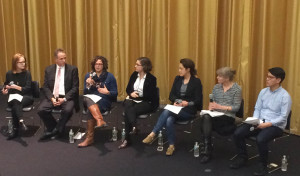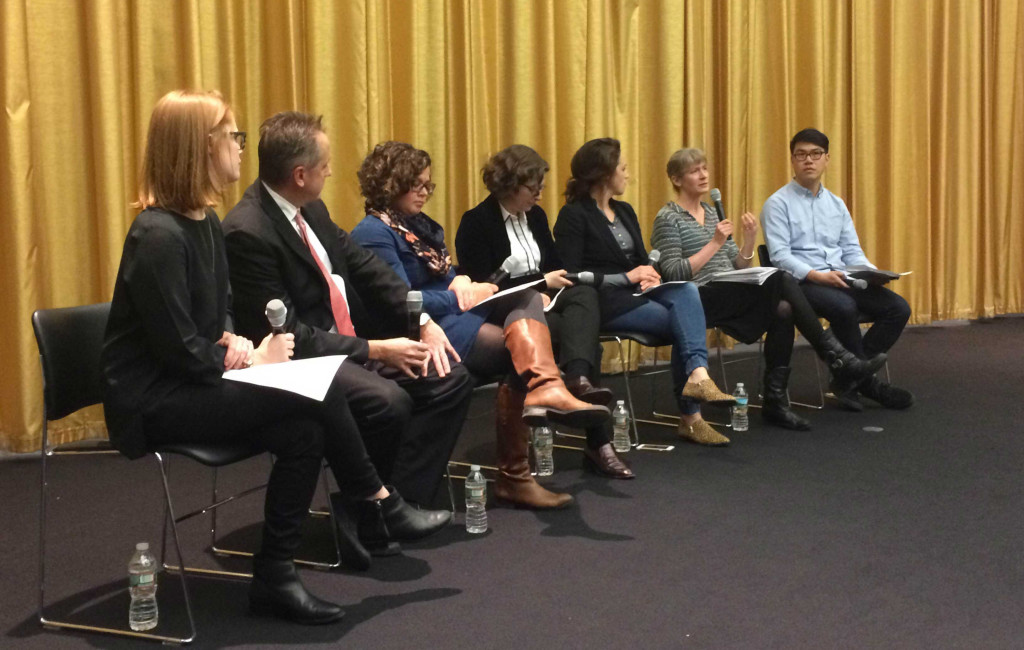Get Hired! (No Promises) Panel and Reception Connects Students and Alumni
 On Tuesday, January 26, 2016, over 100 GSD students and recent graduates filled Piper Auditorium for Get Hired! (No Promises) panel discussion and reception. Alumni and friends from the GSD’s core disciplines of architecture, landscape architecture, urban planning, urban design, and design studies shared their expertise on the hiring process and career navigation. Sponsored by Development and Alumni Relations, this panel is part of the Office’s initiatives to join alumni and students through communications, volunteer opportunities, and events. Students and recent graduates were exposed to both the private and public sectors and a range of employers, including the National Park Service, MIT Media Lab, Sasaki Associates, Northeastern University, Elkus Manfredi, and Supernormal.
On Tuesday, January 26, 2016, over 100 GSD students and recent graduates filled Piper Auditorium for Get Hired! (No Promises) panel discussion and reception. Alumni and friends from the GSD’s core disciplines of architecture, landscape architecture, urban planning, urban design, and design studies shared their expertise on the hiring process and career navigation. Sponsored by Development and Alumni Relations, this panel is part of the Office’s initiatives to join alumni and students through communications, volunteer opportunities, and events. Students and recent graduates were exposed to both the private and public sectors and a range of employers, including the National Park Service, MIT Media Lab, Sasaki Associates, Northeastern University, Elkus Manfredi, and Supernormal.
Moderators Nina Chase MLA ’12, associate at Sasaki Associates and adjunct lecturer at Northeastern University, and Chris SooHoo MArch ’16, aligned the conversation around three key segments: getting started with the job hunt, interview success, and negotiating the offer.
When posed questions about what efforts could make applications stand out during the job search, the panelists emphasized the importance of a well-crafted and cu rated portfolio. Key questions to ask during the interview process, and how to gauge the office culture and work/life balance were noteworthy discussion topics. Elizabeth Christoforetti MArch ’09, who leads the Big Data for Small Places research team at the MIT Media Lab and is the Founder and Lead Designer for Supernormal, revealed that there are two stages for applicants to stand out: “The first level is critical information up front fast.” She prefers a short cover letter that is specific to the firm and includes software skills. The second level is an analysis on a “deeper level of are you the right fit.”
rated portfolio. Key questions to ask during the interview process, and how to gauge the office culture and work/life balance were noteworthy discussion topics. Elizabeth Christoforetti MArch ’09, who leads the Big Data for Small Places research team at the MIT Media Lab and is the Founder and Lead Designer for Supernormal, revealed that there are two stages for applicants to stand out: “The first level is critical information up front fast.” She prefers a short cover letter that is specific to the firm and includes software skills. The second level is an analysis on a “deeper level of are you the right fit.”
Laura Pitone, director of talent and organizational development at Sasaki Associates, also highlighted the importance of fit. She seeks candidates who define themselves as both artists and leaders and suggests that applicants “Be as clear as you can about what you are bringing to the table and what is unique about your experience.” She stressed the importance of emphasizing a connection to the firm and why you are interested in the position: “I want to know what you are passionate about and at the same time, why you want to make a connection.”
For the perspective of employment opportunities in the public domain, as well as the opportunity to work with a federal agency as a private sector contractor, Margaret C. Brown MLA ’92, who has worked for the National Park Service Olmsted Center for Landscape Preservation based in Boston as a Senior Project Manager/Historical Landscape Architect since 1990, provided her tips for applying through the complex USAjobs.gov. Applicants are scored through an initial gatekeeping process based on knowledge, skills, and abilities. Because the site is not able to handle graphics, she suggests an online portfolio with a link included in the application or to incorporate into cover letters and resumes.

L-R: Nina Chase MLA ’12, John Martin MArch ’89, Angel Williams MUP ’08, Laura Pitone, Elizabeth Christoforetti MArch ’09, Margaret C. Brown MLA ’92, and Chris SooHoo MArch ’16.
The top job search tip from Angel Williams MUP ’08, campus planning manager at Northeastern University, is the power of connections. “Networking is probably the biggest thing. Every job I’ve gotten has been from someone I’ve worked with, or had a connection with in school such as a professor or critic. It is very important to keep your network going as your career develops and staying connected.” During interviews, she finds reviewing materials on iPads or a memorable portfolio to be helpful, plus she advises that job seekers be certain to bring resume copies. John Martin MArch ’89, principal at Elkus Manfredi Architects, who is an architect and urban planner, emphasized the GSD’s unmatched reputation, award-winning faculty, and cutting-edge research set applicants apart.
Once a job offer is received, panelists advised the audience to carefully consider the full package. There may be other benefits beyond the salary that can be negotiated. On the topic of starting salary and negotiations, John Martin suggested inquiring about a company’s salary structure. Although there is not much variance in starting salary at his firm since it is a meritocracy where contributions will impact salary, opportunities for growth are reflected in commensurate salary increases. When evaluating a position, he advises that it is “more about finding the right fit than the right number.”
With international students comprising 48% of the GSD student body, guidance around visa status/sponsorship during an interview process was also an important conversation topic. The panel led into a Q&A session with the audience, which was followed by a networking meet and greet for students and young alumni to connect with the panelists for more in-depth conversations.
This spring’s upcoming programs between alumni and students include portfolio reviews in March, the Unsung Hero awards (nominated by fellow students, awarded by the Alumni Council), and Unsung Hero and mentoring breakfasts in April. For more information on how you can get involved, please email [email protected].
